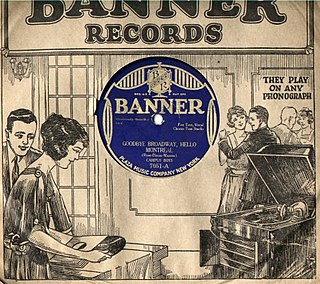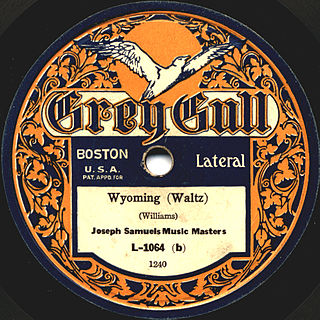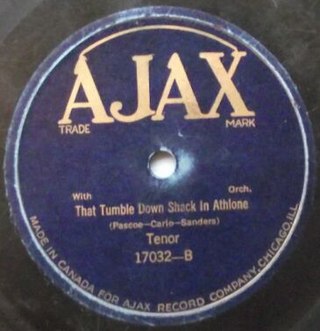
In music, a single is a type of release of a song recording of fewer tracks than an album or LP record, typically one or two tracks. A single can be released for sale to the public in a variety of physical or digital formats. Singles may be standalone tracks or connected to an artist's album, and in the latter case would often have at least one single release before the album itself, called lead singles.

Brunswick Records is an American record label founded in 1916.

OKeh Records is an American record label founded by the Otto Heinemann Phonograph Corporation, a phonograph supplier established in 1916, which branched out into phonograph records in 1918. The name was spelled "OkeH" from the initials of Otto K. E. Heinemann but later changed to "OKeh". In 1965, OKeh became a subsidiary of Epic Records, a subsidiary of Sony Music. OKeh has since become a jazz imprint, distributed by Sony Masterworks.

Durium was a short-lived record label in the United Kingdom run by Durium Products (GB) Ltd in the 1930s.

The American Record Company was an American record label that was in business from 1904 to 1906.

Banner Records was an American record company and label in the 1920s and 1930s. It was created primarily for the S.S. Kresge Company, though it was employed as a budget label in other discount stores.

Grey Gull Records was a record company and label founded in Boston, Massachusetts in 1919. The company was started by Theodore Lyman Shaw, a member of an upper class family from Wellesley, Massachusetts.

Domino Records was an American record label, in existence from 1924 to 1933.

Vogue Records was a short-lived United States–based record label of the 1940s, noted for the artwork embedded in the records themselves. Founded in 1946 as part of Sav-Way Industries of Detroit, Michigan, the discs were initially a hit, because of the novelty of the colorful artwork, and the improved sound compared to the shellac records dominant at the time. The discs were manufactured by first sandwiching printed illustrations around a core of aluminum, then coating both sides with clear vinyl upon which the grooves were stamped.

American Record Corporation (ARC), also referred to as American Record Company, American Recording Corporation, or ARC Records, was an American record company in operation from 1929 to 1938, and again from 1978 to 1982.

Picture discs are gramophone (phonograph) records that show images on their playing surface, rather than being of plain black or colored vinyl. Collectors traditionally reserve the term picture disc for records with graphics that extend at least partly into the actual playable grooved area, distinguishing them from picture label discs, which have a specially illustrated and sometimes very large label, and picture back discs, which are illustrated on one unplayable side only.

Odeon Records is a record label founded in 1903 by Max Straus and Heinrich Zuntz of the International Talking Machine Company in Berlin, Germany. The label's name and logo come from the Odéon-Théâtre de l'Europe in Paris.
JSP Records is a British record label, founded in 1978 by John Stedman, releasing recordings by blues musicians such as Professor Longhair, Buddy Guy, Jimmy Witherspoon, Louisiana Red, Deitra Farr, Charlie Sayles, Eddie "Cleanhead" Vinson, Kansas City Red, Eddie Taylor, and Big John Wrencher. The label is based in London, England.
"I'm Walking Behind You" is a popular song which was written by Billy Reid and published in 1953. The recording by American singer Eddie Fisher was a No. 1 hit in both the US and UK Singles charts, but it had previously been recorded by Reid's former partner, Dorothy Squires, who had a hit with the song in the UK.

Ajax Records was a record company and label founded in 1921. Jazz and blues records were produced in New York City, with some in Montreal, and marketed via the Ajax Record Company of Chicago.

Durium is a highly durable synthetic resin developed in 1929. It was used in phonograph records, as well as in the casting process for metallic type and in the aeronautics industry.

"Moonlight Serenade" is an American swing ballad composed by Glenn Miller with subsequent lyrics by Mitchell Parish. It was an immediate phenomenon when released in May 1939 as an instrumental arrangement, though it had been adopted and performed as Miller's signature tune as early as 1938, even before it had been given the name "Moonlight Serenade". In 1991, Miller's recording of "Moonlight Serenade" was inducted into the Grammy Hall of Fame.
In the production of phonograph records – discs that were commonly made of shellac, and later, vinyl – sound was recorded directly onto a master disc at the recording studio. From about 1950 on it became usual to have the performance first recorded on audio tape, which could then be processed and/or edited, and then dubbed on to the master disc.

The discography of Sergio Franchi, the Italian-American tenor (1926–1990), consists of a total of thirty-five albums: Two live albums, and thirty-three studio albums. The studio albums are further identified as collaborations, and nine are compilation albums. The Live category included an LP album (1965) and a CD album of selected songs extracted from Franchi's twenty-four Live TV appearances on The Ed Sullivan Show. This discography also includes thirty single and EP albums recorded or released in various venues.
Durium was an Italian record label, active from 1935 to 1989. Part of the catalogue and the brand were subsequently taken over by Ricordi, who used it for some reissues. Its initial trademark consisted of the writing Durium in block letters, surmounted by the stylisation of three trumpets and an eagle. Immediately after the war, this logo was abandoned to move to the stylisation of a disk with three internal rays crossed by the writing Durium in italics.
















